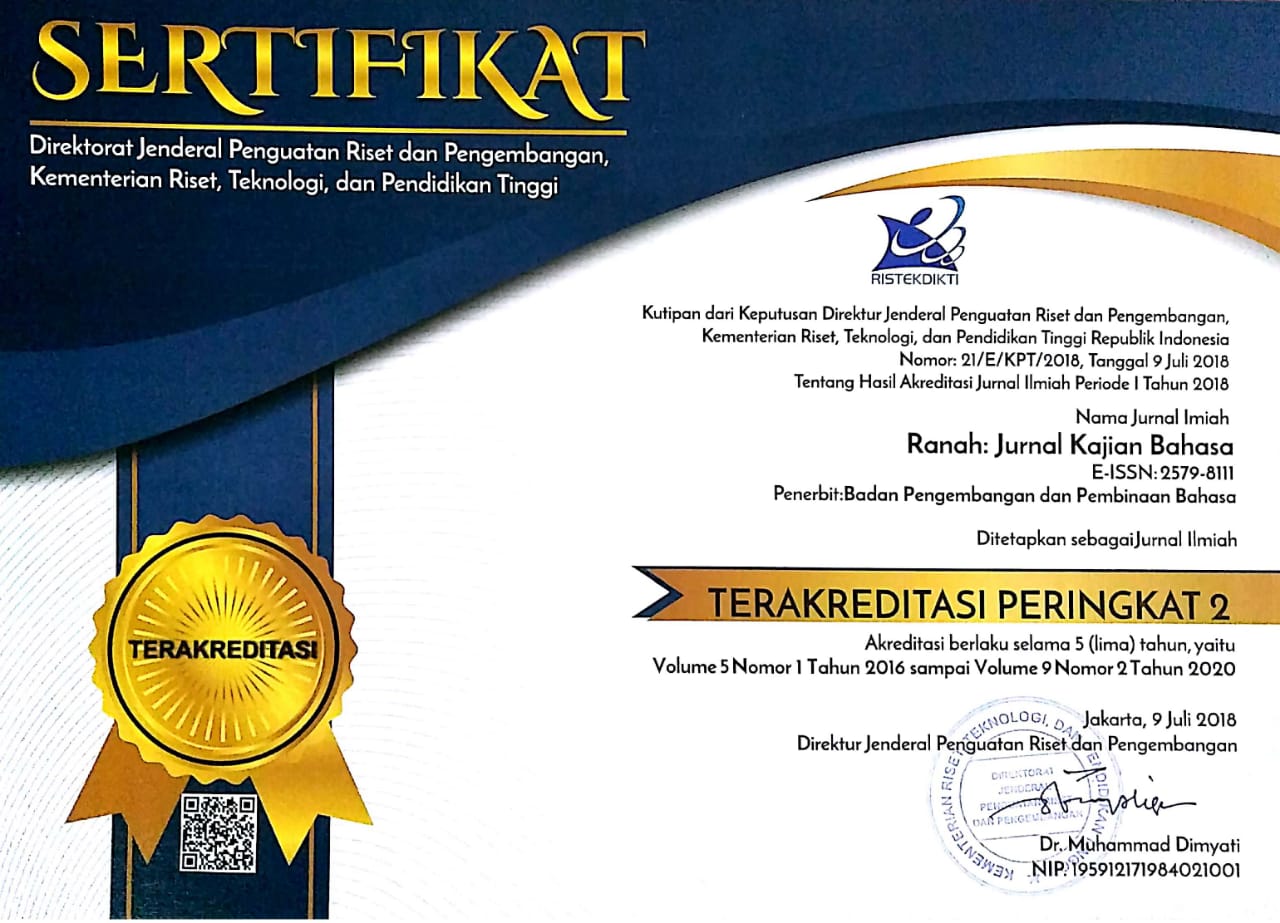Ciri Morfosintaktis Afiks Derivasional {Ber-} dalam Konstruksi Verba Deadjektival Bahasa Indonesia
Abstract
The affix {ber-} in Indonesian is commonly used to derive adjectives into deadjectival verbs (VDaj). This research aimed to describe the affix {ber-} morphosyntactic characteristics in constructing Indonesian VDaj. The data was collected from bI sentence constructions marked by the affix {ber-} or its variations, which were obtained from the Indonesian-Leipzig Corpora Collection (ILCC) and the SEAlang Library Indonesian Corpus (SLIC). The analysis produced two findings based on the technique of immediate constituent and the theory of Derivational Morphology and Derivational Syntax. Firstly, the morphosyntactic features of affix {ber-} in constructing Indonesian VDaj can only be formed if the affix {ber-} and adjectives are involved. Secondly, there were three tendencies of morphosyntactic characteristics of affix {ber}: (a) creating one-valence VDaj, (b) forming intransitive VDaj, and (c) embedding predicative and appositive functions of VDaj. The analysis of the morphosyntactic features of the affix {ber-} is expected to contribute to the advancement of Derivational Morphology and Derivational Syntax theories by elucidating the formation and function of VDaj bI. The results of this research are helpful for further exploration, especially for exploring the morphosyntactic characteristics of other derivational affixes in Indonesian verb constructions.
Abstrak
Verba bahasa Indonesia (bI) merupakan kategori gramatikal yang cenderung bersifat resipien universal karena dapat menerima berbagai kategori kata sebagai unsur dasar konstruksinya. Secara morfologis, kata sifat atau adjektiva merupakan salah satu kategori yang lazim dikonstruksikan sebagai verba deadjektival (VDaj) melalui derivasi bersama afiks {ber-}. Kajian ini bertujuan memerikan ciri-ciri morfosintaktis afiks {ber-} dalam konstruksi VDaj bI tersebut. Data kajian ini berwujud konstruksi kalimat bI yang memiliki konstituen VDaj berpemarkah afiks {ber-} atau variasi realisasi morfologisnya seperti {ber-an}, {ber-R}, dan {ber-kan}. Sumber data kajian ini adalah Indonesian – Leipzig Corpora Collection (ILCC) dan SEAlang Library Indonesian Corpus (SLIC). Data dikumpulkan melalui teknik simak/observasi leksikal. Data dianalisis berdasarkan teknik bagi-unsur-langsung dengan mengacu pada teori Morfologi Derivasional dan Sintaksis Derivasional. Berdasarkan analisis, dihasilkan dua temuan sebagai berikut. Pertama, secara gramatikal, ciri morfosintaktis afiks {ber-} dalam konstruksi VDaj bI dapat terbentuk hanya jika afiks {ber-} beserta adjektiva terlibat bersama-sama sebagai input pada proses pembentukan kata. Kedua, secara khusus, terdapat sekurang-kurangnya tiga kecenderungan ciri morfosintaktis afiks {ber-}, yaitu (a) menciptakan VDaj bervalensi satu, (b) membentuk VDaj intransitif, dan (c) menyematkan fungsi predikatif dan apositif pada VDaj. Analisis terhadap ciri morfosintaktis afiks {ber-} ini diharapkan dapat memperkaya teori Morfologi Derivasional dan Sintaksis Derivasional dalam menjelaskan pembentukan dan fungsi VDaj bI. Hasil kajian ini juga bermanfaat bagi penelitian selanjutnya, khususnya untuk penelusuran ciri morfosintaktis afiks-afiks derivasional lainnya dalam konstruksi verba bI.
Keywords
Full Text:
PDFReferences
Aikhenvald, A. Y. (2007). Typological Distinctions in Word-Formation. In Language Typology and Syntactic Description (pp. 1-65). Cambridge University Press. https://doi.org/10.1017/CBO9780511618437.001
Anagnostopoulou, E., & Samioti, Y. (2014). Domains Within Words and Their Meanings. In The Syntax of Roots and the Roots of Syntax (pp. 81-111). Oxford University PressOxford. https://doi.org/10.1093/acprof:oso/9780199665266.003.0005
Anderson, J. M. (2007). Finiteness, Mood, and Morphosyntax. Journal of Linguistics, 43(1), 1-32. https://doi.org/10.1017/S0022226706004439
Anderson, S. R. (2015). The Morpheme: Its Nature and Use. In M. Baerman (Ed.), The Oxford Handbook of Inflection (pp. 10-34). Oxford University Press. https://doi.org/10.1093/oxfordhb/9780199591428.013.2
Andreou, M. (2017). The Semantics of Compounding. Morphology, 27(4), 721-725. https://doi.org/10.1007/s11525-017-9311-1
Arad, M. (2005). Roots: Where Syntax, Morphology, and the Lexicon Meet. In M. Arad (Ed.), Roots and Patterns: Hebrew Morpho-syntax (pp. 1-23). Springer Netherlands. https://doi.org/10.1007/1-4020-3244-7_1
Arche, M. J., Fábregas, A., & Marín, R. (2021). On Event-Denoting Deadjectival Nominalizations. Linguistic Review, 38(2), 191-231. https://doi.org/10.1515/tlr-2021-2063
Asrumi, A., Subroto, E., & Sudaryanto, S. (2014). The Semantic Relation of Denominal, Deverbal, and Deadjectival Verbs with Other Arguments in the Osing Language. International Journal of Linguistics, 6(2), 62-80. https://doi.org/10.5296/ijl.v6i2.5345
Baerman, M., Brown, D., & Corbett, G. G. (2005). The Syntax-Morphology Interface. Cambridge University Press.
https://doi.org/10.1017/CBO9780511486234
Barzegar, H., & Karimi doustan, G. (2017). Lexical Aspect in Persian Deadjectival Complex Predicates. Language Research, 8(1), 41-57. https://doi.org/10.22059/jolr.2017.63134
Bauer, L. (2019a). Notions of Paradigm and Their Value in Word-formation. Word Structure, 12(2), 153-175. https://doi.org/10.3366/word.2019.0144
Bauer, L. (2019b). Rethinking morphology. Edinburgh. Edinburgh University Prrss.
Bauer, L., Lieber, R., & Plag, I. (2015). The Oxford Reference Guide to English Morphology. The Oxford Reference Guide to English Morphology. https://doi.org/10.1093/acprof:oso/9780198747062.001.0001
Beavers, J., Everdell, M., Jerro, K., Kauhanen, H., Koontz-Garboden, A., Lebovidge, E., & Nichols, S. (2021). States and Changes of State: A Crosslinguistic Study of the Roots of Verbal Meaning. Language, 97(3), 439-484. https://doi.org/10.1353/lan.2021.0044
Berg, K. (2021). Productivity, Vocabulary Size, and New Words. A Response to Säily (2016). Corpus Linguistics and Linguistic Theory, 17(1), 177-187. https://doi.org/10.1515/cllt-2017-0075
Blevins, J. P. (2016). Word and Paradigm Morphology. Oxford University Press. https://doi.org/10.1093/acprof:oso/9780199593545.001.0001
Blom, C. (2005). The Demarcation of Morphology and Syntax (pp. 53-66). https://doi.org/10.1075/cilt.264.04blo
Booij, G. (2007a). The Grammar of Words. Oxford University PressOxford. https://doi.org/10.1093/acprof:oso/9780199226245.001.0001
Booij, G. (2007b). The Word as a Linguistic Unit. In The Grammar of Words (pp. 281-294). Oxford University PressOxford. https://doi.org/10.1093/acprof:oso/9780199226245.003.0012
Booij, G. (2015). Word-Formation in Construction Grammar. Word-Formation: An International Handbook of the Languages of Europe, 1, 188-202. https://doi.org/10.1515/9783110246254-014
Booij, G. (2016). Construction Morphology. In The Cambridge Handbook of Morphology (pp. 424-448). Cambridge University Press. https://doi.org/10.1017/9781139814720.016
Caballero, G., & Inkelas, S. (2013). Word Construction: Tracing an Optimal Path Through the Lexicon. Morphology, 23(2), 103-143. https://doi.org/10.1007/s11525-013-9220-x
Chaer, A. (2008). Morfologi Bahasa Indonesia. Rineka Cipta.
Cifuentes Honrubia, J. L. (2011). Spanish Deadjectival Verbs and Argument Structure. In J. L. C. Honrubia & S. R. Rosique (Eds.), Spanish Word Formation and Lexical Creation (pp. 65-106). https://doi.org/10.1075/ivitra.1.04hon
Dixon, R. M. W. (2014). Making New Words. Oxford University Press.
https://doi.org/10.1093/acprof:oso/9780198712367.001.0001
Embick, D. (2013). Morphemes and Morphophonological Loci. Distributed Morphology Today: Morphemes for Morris Halle, 151-166.
https://doi.org/10.7551/mitpress/9780262019675.003.0009
Embick, D., & Noyer, R. (2007). Distributed Morphology and the Syntax-Morphology Interface. Oxford University Press.
https://doi.org/10.1093/oxfordhb/9780199247455.013.0010
Farkas, I.-Á. (2015). Denominal and Deadjectival Verbs are Compatible with Resultative Phrases. SKASE Journal of Theoretical Linguistics, 12(4). http://www.skase.sk/Volumes/JTL30/pdf_doc/03.pdf
Firdaus, W. (2011). Morfofonemis Kata Serapan dalam Bidang Hukum Indonesia. Lingua, 6(1), 69-80.
Folli, R., & Harley, H. (2013). The Syntax of Argument Structure: Evidence from Italian Complex Predicates. Journal of Linguistics, 49(1), 93-125. https://doi.org/10.1017/S0022226712000072
Fradin, B. (2020). Characterizing Derivational Paradigms. Empirical Approaches to Linguistic Theory, 16, 49-84.
https://doi.org/10.1163/9789004433410_004
Golfam, A., Maleki Moqaddam, A., & Ebrahim Poornik, F. (2018). Constraints on the Productivity of Denominal and Deadjectival Verbs in Standard Farsi. Research in Western Iranian Languages and Dialects, 6(20), 109-132. https://jlw.razi.ac.ir/article_838.html
Haspelmath, M. (2012). How to Compare Major Word-Classes Across the World's languages. UCLA Working Papers in Linguistics, Theories of Everything, 17(16), 109-130.
Haspelmath, M. (2020). The Morph as a Minimal Linguistic Form. Morphology, 30(2), 117-134. https://doi.org/10.1007/s11525-020-09355-5
https://doi.org/10.1007/s11525-020-09355-5
Haspelmath, M., & Sims, A. (2010). Understanding Morphology (2nd ed.). Routledge.
Jackendoff, R., & Audring, J. (2019). The Texture of the Lexicon. Oxford University Press. https://doi.org/10.1093/oso/9780198827900.001.0001
Julien, M. (2002). Syntactic Heads and Word Formation. Oxford University Press. https://doi.org/10.1093/oso/9780195149500.001.0001
Kearns, K. (2007). Telic Senses of Deadjectival Verbs. Lingua, 117(1), 26-66. https://doi.org/10.1016/j.lingua.2005.09.002
Keine, S. (2013). Syntagmatic Constraints on Insertion. Morphology, 23(2), 201-226. https://doi.org/10.1007/s11525-013-9221-9
Kjellmer, G. (2001). Why Weaken But Not *Strongen? On Deadjectival Verbs. English Studies, 82(2), 154-171. https://doi.org/10.1076/enst.82.2.154.9600
Koontz-Garboden, A. (2010). The Lexical Semantics of Derived Statives. Linguistics and Philosophy, 33(4), 285-324. https://doi.org/10.1007/s10988-011-9082-9
Körtvélyessy, L., Bagasheva, A., & Štekauer, P. (2020). Derivational Networks Across Languages. Derivational Networks Across Languages, 1-610. https://doi.org/10.1515/9783110686630
Kridalaksana, H. (2009). Pembentukan Kata dalam Bahasa Indonesia. Gramedia Pustaka Utama.
Landau, I. (2009). Saturation and Reification in Adjectival Diathesis. Journal of Linguistics, 45(2), 315-361.
https://doi.org/10.1017/S0022226709005714
Lee, C. (2013). Change of Location and Change of State (pp. 291-310). https://doi.org/10.1007/978-94-007-5189-7_13
Indonesian-Leipzig Corpora Collection: Indonesian Mixed Corpus Based on Material From 2013. Leipzig Corpora Collection. [Dataset]. https://corpora.uni-leipzig.de?corpusId=ind_mixed_2013.
Lieber, R. (2006a). Syntax of Words. In Encyclopedia of Language & Linguistics (pp. 405-408). Elsevier. https://doi.org/10.1016/B0-08-044854-2/00144-9
Lieber, R. (2006b). The Category of Roots and the Roots of Categories: What we Learn from Selection in Derivation. Morphology, 16(2), 247-272. https://doi.org/10.1007/S11525-006-9106-2
Lieber, R. (2015). Word-Formation in Generative Grammar. Word-Formation: An International Handbook of the Languages of Europe, 1, 94-112. https://doi.org/10.1515/9783110246254-009/HTML
Lieber, R. (2017). Derivational Morphology. In Oxford Research Encyclopedia of Linguistics. Oxford University Press. https://doi.org/10.1093/acrefore/9780199384655.013.248
Lieber, R., Štekauer, P., & Štekauer, P. (2015). Derivational Paradigms. The Oxford Handbook of Derivational Morphology. https://doi.org/10.1093/OXFORDHB/9780199641642.013.0020
Manova, S. (2011). Understanding Morphological Rules. Understanding Morphological Rules. https://doi.org/10.1007/978-90-481-9547-3
Mel'cuk, I. (2006). Aspects of the Theory of Morphology (D. Beck, Ed.). Mouton de Gruyter. https://doi.org/10.1515/9783110199864
Mugdan, J. (2015). Units of Word-Formation. Word-Formation: An International Handbook of the Languages of Europe, 1, 235-301.
https://doi.org/10.1515/9783110246254-017
Nakajima, T. (2021). Heads and Layers in Agglutination: A Case in Deadjectival Psych Verbs with -garu in Japanese. Open Linguistics, 7(1), 42-65. https://doi.org/10.1515/opli-2021-0003
Nugraha, D. S. (2017). Ketransitifan Verba Denominatif dalam Konstruksi Kalimat Bahasa Indonesia (Transitivity of Denominative Verbs in Indonesian Sentence Construction). SINTESIS, 11(02), 78-86. https://doi.org/https://doi.org/10.24071/sin.v11i2.1735
Nugraha, D. S. (2020). The Comparative Analysis of Syntactic Features Between Indonesian and English Denominal Verbs. LiNGUA: Jurnal Ilmu Bahasa Dan Sastra, 15(1), 65-78.
https://doi.org/10.18860/ling.v15i1.7680
Nugraha, D. S. (2021a). Makna-Makna Gramatikal Konstruksi Verba Denominatif dalam Bahasa Indonesia (The grammatical meanings of denominative verb constructions in Indonesian). Bahasa dan Seni: Jurnal Bahasa, Sastra, Seni, dan Pengajarannya, 49(2), 224-239. https://doi.org/10.17977/um015v49i22021p224
https://doi.org/10.17977/um015v49i22021p224
Nugraha, D. S. (2021b). Morphosemantic Features of Derivational Affix {Me(N)-} in The Indonesian Denumeral Verb Constructions. Sirok Bastra, 9(2), 125-134. https://doi.org/10.37671/sb.v9i2.317
Nugraha, D. S. (2022). Ciri Morfosemantik Afiks Derivasional {ber-} dalam Konstruksi Verba Denumeralia Bahasa Indonesia (Morphosemantic Features of Derivational Affix {ber-} in Indonesian Denumeral Verb Constructions). Indonesian Language Education and Literature, 8(1), 31-47. https://doi.org/10.24235/ileal.v8i1.9543
Nugraha, D. S. (2024a). Analyzing the Derivational Verb of Indonesian Based on the Derivational Morphology. South Asian Research Journal of Arts, Language and Literature, 6(01), 1-11. https://doi.org/10.36346/sarjall.2024.v06i01.001
Nugraha, D. S. (2024b). Some Notes on Indonesian Word Formation: A Study Based on the Derivational Morphology Approach. South Asian Research Journal of Humanities and Social Sciences, 6(01), 20-31. https://doi.org/10.36346/sarjhss.2024.v06i01.004
Nugraha, D. S., & Baryadi, I. P. (2019). The Morphological Comparison of Denominal Verbs in The Bahasa Indonesia and The English. Sirok Bastra, 7(2), 107-117. https://doi.org/10.37671/sb.v7i2.171
Padó, S., Herbelot, A., Kisselew, M., & Šnajder, J. (2016). Predictability of Distributional Semantics in Derivational Word Formation. Proceedings of {COLING} 2016, the 26th International Conference on Computational Linguistics: Technical Papers.
Panagiotidis, E. P. (2011). Categorial Features and Categorizers. The Linguistic Review, 28(3). https://doi.org/10.1515/tlir.2011.010
https://doi.org/10.1515/tlir.2011.010
Panagiotidis, E. P. (2014). Categorial Features. Cambridge University Press. https://doi.org/10.1017/CBO9781139811927
Ramchand, G. C. (2008). Verb Meaning and the Lexicon. Cambridge University Press. https://doi.org/10.1017/CBO9780511486319
Rice, K. (2011). Principles of Affix Ordering: An Overview. Word Structure, 4(2), 169-200. https://doi.org/10.3366/word.2011.0009
Roßdeutscher, A. (2014). When Roots License and When They Respect Semantico‐Syntactic Structure in Verbs. In The Syntax of Roots and the Roots of Syntax (pp. 282-309). Oxford University PressOxford. https://doi.org/10.1093/acprof:oso/9780199665266.003.0013
Satyawati, M. S., Krisnawati, N. L. P., & Artawa, K. (2019). On the Syntax of Adjectives and Deadjectival Verbs in Indonesian. Community-Based Linguistics: The Mindoro Experience, 29th Southeast Asian Linguistic Society (SEALS).
SEAlang Library Indonesian Corpus. [Dataset]. http://sealang.net/indonesia/corpus.htm
Sims, A. D., & Parker, J. (2015). Lexical Processing and Affix Ordering: Cross-Linguistic Predictions. Morphology, 25(2), 143-182. https://doi.org/10.1007/s11525-015-9257-0
Sneddon, J. N. (1996). Indonesian: A Comprehensive Grammar. Routledge.
Spathas, G., & Michelioudakis, D. (2021). States in the Decomposition of Verbal Predicates. Natural Language & Linguistic Theory, 39(4), 1253-1306. https://doi.org/10.1007/s11049-020-09496-6
Spencer, A. (2015). Derivation. Word-Formation: An International Handbook of the Languages of Europe, 1, 301-321.
https://doi.org/10.1515/9783110246254-018
Spyropoulos, V., Revithiadou, A., & Panagiotidis, P. (2015). Verbalizers Leave Marks: Evidence from Greek. Morphology, 25(3), 299-325. https://doi.org/10.1007/s11525-015-9260-5
Štekauer, P. (2015). The Delimitation of Derivation and Inflection. Word-Formation: An International Handbook of the Languages of Europe, 1, 230-235. https://doi.org/10.1515/9783110246254-016
Stump, G., & Finkel, R. A. (2013). Morphological Typology. Cambridge University Press. https://doi.org/10.1017/CBO9781139248860
Sugioka, Y. (2000). Transitivity Alternations in Deadjectival Verbs.
Tham, S. W. (2013). Change of State Verbs and Result State Adjectives in Mandarin Chinese. Journal of Linguistics, 49(3), 647-701. https://doi.org/10.1017/S0022226713000261
Tolskaya, I. K. (2015). Verbal prefixes in Russian: Conceptual Structure Versus Syntax. Journal of Linguistics, 51(1), 213-243. https://doi.org/10.1017/S0022226714000206
Wible, D., & Tsao, N.-L. (2020). Constructions and the Problem of Discovery: A Case for the Paradigmatic. Corpus Linguistics and Linguistic Theory, 16(1), 67-93. https://doi.org/10.1515/cllt-2017-0008
Wunderlich, D. (2006). Syntax: Optimality Theory. In K. Brown (Ed.), Encyclopedia of Language & Linguistics (pp. 408-418). Elsevier. https://doi.org/10.1016/B0-08-044854-2/04213-9
DOI: https://doi.org/10.26499/rnh.v13i1.6041
Refbacks
- There are currently no refbacks.








